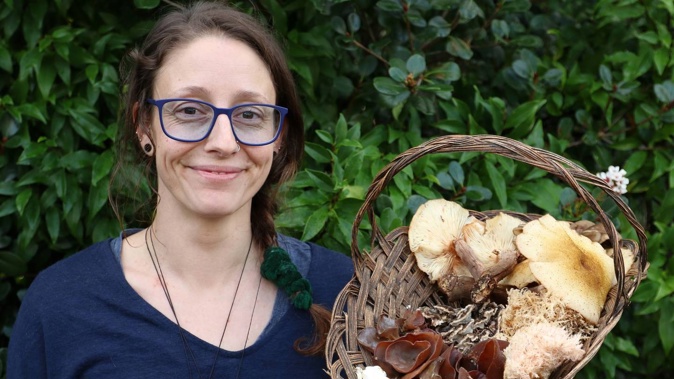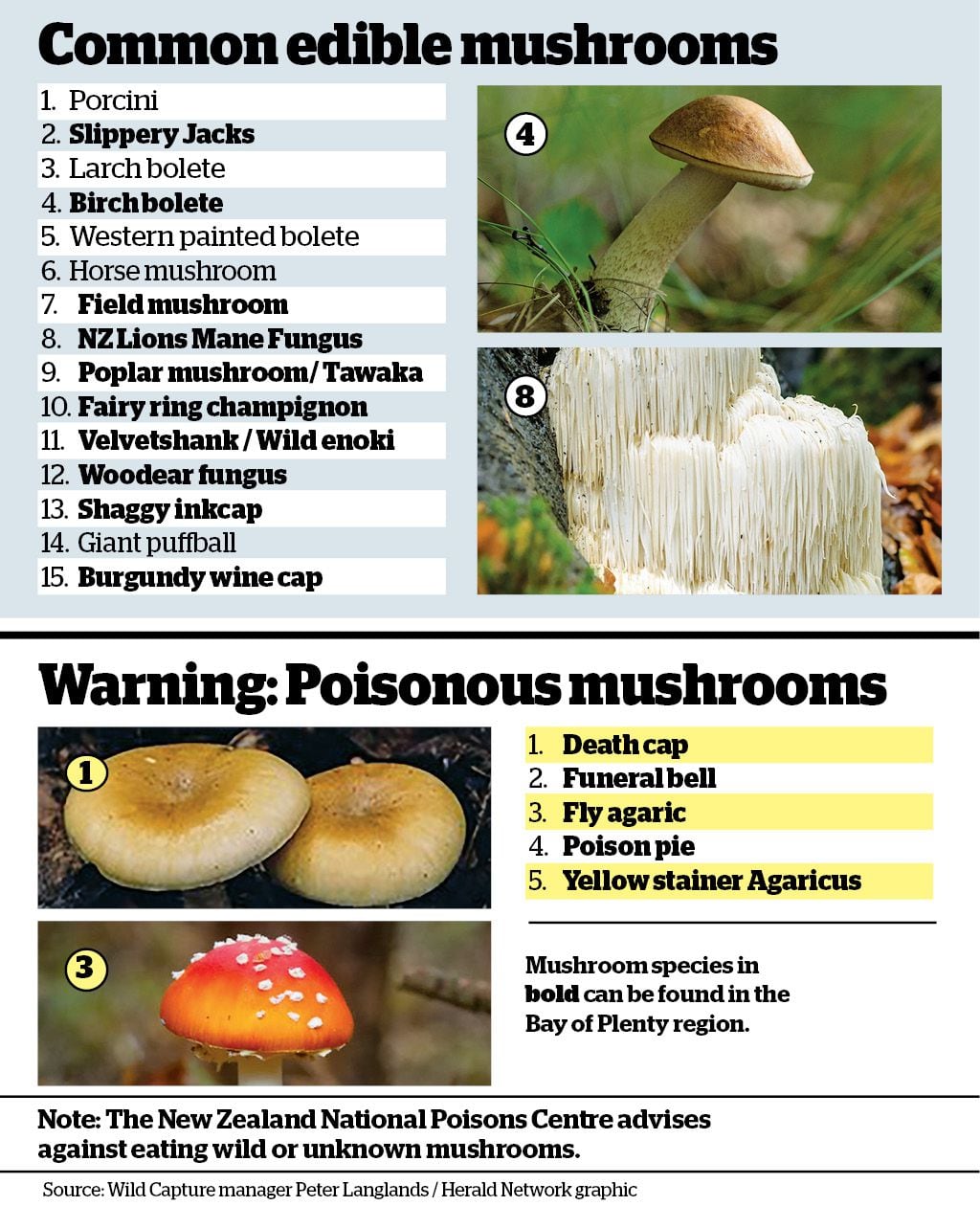
The headline-grabbing suspected mushroom lunch poisoning deaths of three people in Australia have led to increased interest — and increased fear — of fungi. In New Zealand, the National Poisons Centre warns against eating wild mushrooms but for many Kiwis foraging for food is a way of life. Maryana Garcia canvasses experts about eating wild mushrooms in Aotearoa.
Humans, Sharn Steadman says, are “more closely related to mushrooms than plants”.
The Te Puke-based Manaaki Mushrooms educator and forager made the point to support her case that mushrooms need not be feared and, contrary to their “bad rap”, were doing a lot of good in the world.
“They’re responsible for sharing the nutrients between trees, they make soil and they break down pollution.”
Steadman told NZME the suspected mushroom poisoning deaths in Australia had led to both an increased interest in and a fear of fungi.
“We hear stories in the news and we get a fright and we respond with a knee-jerk fear reaction.
“Some people even go so far as to warn against touching mushrooms. [But] you can touch all mushrooms safely. Mushrooms have to go into your stomach to cause you harm.”
Steadman said news of a mushroom poisoning death could also lead some to fear foraging.
“They think to identify mushrooms you need special powers or something,” Steadman said.
“But with enough motivation and attention to details, identifying mushrooms is enjoyable.”
- 'Does that make her a killer?': Ex-cop on the case against mushroom poisoning suspect
- Mushroom suspect says she's no 'evil witch', victim's dying words passed to police
- Deadly mushroom twist: Chef an 'experienced' fungi forager, says friend

She said anyone interested in foraging for wild mushrooms needed to cultivate a sense of responsibility.
“There are no warning signs for poisonous mushrooms. Toxic and deadly mushrooms can taste and smell amazing.”
She said the death cap mushroom, believed to have been eaten in the fatal Australian lunch, was commonly found in areas where other edible mushrooms might grow.
Steadman said death caps often grew under introduced trees such as oaks and had olive-green caps and white gills.
“They start off as a little egg in the ground. So when you harvest the mushroom you can still see the sack intact,” Steadman said.
“The death cap also has a ring or a skirt that hangs around the stem where the gills are.
“It’s important to learn about the mushroom you want to find and all the mushrooms that you could get it confused with.”
Steadman recommended using the iNaturalist app or visiting the Mushroom Hunting New Zealand Facebook page for more information.
/cloudfront-ap-southeast-2.images.arcpublishing.com/nzme/ZP6OGJCGYMWLGQR7RAW4KCGPGE.jpg) Te Puke-based Manaaki Mushrooms educator and forager Sharn Steadman.
Te Puke-based Manaaki Mushrooms educator and forager Sharn Steadman.
Ben Thomas, owner of Wairakei mushroom farm Forage, has enjoyed finding mushrooms since childhood.
“We enjoyed gathering field mushrooms off the farm and some oyster varieties from in the bush, although these proved more difficult to find.”
Thomas said he became interested in mushrooms for their culinary attributes and medicinal purposes.
“They are extremely versatile and can be applied in many ways.”
Thomas said eating mushrooms had “hundreds of benefits”. He said the variety he grew, oyster mushrooms, were a good source of essential nutrients including vitamins, minerals and dietary fibre, rich in antioxidants, supported the immune system and helped heart and digestive health.
Thomas said books and fungi identification groups on Facebook were good first stops for foragers seeking to clearly identify the species of a mushroom before eating it.
“There are lots of books. A personal go-to is Fungi of Aotearoa. It’s easy and concise,” Thomas said.
/cloudfront-ap-southeast-2.images.arcpublishing.com/nzme/JEHEUOCFERCW5D7UWP32MTZCII.JPG)
Conservationist Peter Langlands said the case in Australia had presented an opportunity to spread and deepen knowledge on fungi and mushrooms in New Zealand communities.
“The main take-home message is to educate yourself,” Langlands said.
Langlands was setting up a national wild foods database. He also managed Wild Capture, his foraging and biodiversity initiative focused on building environmental awareness.
Langlands said when it came to identifying edible and poisonous mushrooms there was no a “golden rule”.
“You have to go on a species-by-species basis,” Langlands said.
“Any mushroom you pick is potentially deadly poisonous until you’ve positively identified it.”
But Langlands said this shouldn’t make people “shy” from eating wild mushrooms.
“A lot of mushrooms that are edible are easy to identify.”
/cloudfront-ap-southeast-2.images.arcpublishing.com/nzme/VZWJGVOTMRCYRJRMV7WVDTCJIE.jpg) Conservationist Peter Langlands says when it comes to mushrooms, there's no golden rule.
Conservationist Peter Langlands says when it comes to mushrooms, there's no golden rule.
University of Otago Department of Botany professor and Fungal Network of New Zealand president David Orlovich said the gastrointestinal effects of death cap mushroom poisoning could start as early as six hours after ingestion.
“After those gastro symptoms subside, the liver failure symptoms will become more apparent and this can lead to multiple effects on other organs,” Orlovich said.
“Consequently if people delay seeking treatment because they think they simply have food poisoning then significant damage can already be done to the other organs.”
Orlovich said at that point, if there was no sample of the mushroom left, the first treatments would be based on guessing the cause of the symptoms.
“Many of the treatments are designed to either remove the mushroom from the patient’s stomach, which needs to be done quickly and to protect the liver,” Orlovich said.
“By the time the liver failure is evident then these treatments are less effective.”
Nevertheless, Orlovich said death from the consumption of poisonous mushrooms was “extremely rare”.
“All fungi can be handled, touched, and smelled without concern, though it’s always best to wash one’s hands before handling food. Of the approximately 8000 species recorded so far in New Zealand only a very small number have been recorded as toxic.”
Orlovich said the Fungal Network was not a foraging organisation but was instead studying fungi from the perspective of science.
“We are reluctant to recommend certain kinds of wild mushrooms for eating without suitable pictures and diagnostic features.”
The New Zealand National Poisons Centre’s website advised that “only an experienced mycologist can reliably identify a mushroom”.
“Never try to identify a mushroom yourself,” the website said.
“These days DNA sequencing is often relied upon for official identification.”
The centre’s website recommended people only eat mushrooms bought at a supermarket or market garden.
“Never eat wild or unknown mushrooms. Remove all mushrooms growing in your garden before children or pets enter the area,” the website said.
“Even ‘non-toxic’ wild mushrooms can sometimes cause poisoning due to excessive consumption, difficulty in digestion, spoiled fungi, presence of heavy metals, parasitic growth in fungi or spore allergies.”
Maryana Garcia is a regional reporter writing for the Rotorua Daily Post and the Bay of Plenty Times. She covers local issues, health and crime.
Take your Radio, Podcasts and Music with you









